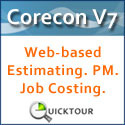
|
www.agc.org Contact Us Archives/Subscribe Advertise IT Forum IT Forum Steering Committee |
4D Augmented Reality Creates Graphic View of ProgressBy Debra Wood
A new 4-dimensional augmented reality system overlays photos captured at a jobsite onto a building information model integrated with scheduling information to automatically display a large-scale construction project’s progress graphically — green for ahead of schedule, red for behind.
"It provides a consistent assessment of progress," says Mani Golparvar-Fard, PhD, assistant professor and director of the Real-time and Automated Monitoring and Control Lab at the University of Illinois at Urbana-Champaign and co-founder and chief technology officer at PAR Works of Boston. He explains that contrasting the BIM model with the photographs creates an opportunity to find any deviations from planned performance.
Golparvar-Fard came up with the idea for the 4 dimensional augmented reality (D4AR) modeling while working at Turner Construction Co., a member of multiple AGC chapters, on a dining hall project while completing his PhD. Everyday at that jobsite, various workers snapped between 250 and 500 photos.
"I saw an opportunity to take these existing photos and turn them into a useful tool for assessment of progress," Golparvar-Fard explains.
The National Science Foundation sponsored the research, conducted by Golparvar-Fard and colleagues, Silvio Savarese at the University of Michigan and Feniosky Peña-Mora at Columbia University in New York. Turner test piloted the D4AR modeling on its World Trade Center Transportation Hub project in New York City.
"What was interesting was the idea of repurposing something we already do and have done for years—daily construction reports and jobsite photos for a historical record," says James P. Barrett, director of Integrated Building Solutions for Turner Construction in New York. "Mani had the idea to apply cutting-edge technology to convert a series of photos to point clouds to create 3D representations of what is in the photo."
Anyone working on the project can upload digital photos taken on the jobsite to a processing server. Within seconds, the D4AR system will generate an image and show in both 2D and 3D how far along the project is and where work may be lagging.
"If we can find ways to improve and automate processes, it would be a huge leap forward in cost savings and efficiencies," Barrett says. "With the cloud-based solution, it’s easy access. You just hit a button, upload, and the cloud will process and then push down the results."
The system allows managers and company executives to remotely monitor progress, navigate through the model, and assess the possibility for delivery time and cost changes. Owners also can use it to track progress and facilitates communication, Golparvar-Fard says.
"It’s a nice opportunity to get field information to bubble up through the organization in a quick and more effective way," Barrett says.
Golparvar-Fard suggests that 4DAR could eliminate the need for subjective daily progress reports. The models also could serve as evidence for dispute resolution and faster, more accurate as-built vs. as-planned evaluation.
The co-developers of the D4AR technology created Vision Construction Monitoring to commercially offer the technology to construction firms. The company determines the cost on a case-by-case basis.
Golparvar-Fard also has developed a similar Mobile Augmented Reality System for smartphones, while a faculty member at Virginia Tech, and the school has licensed those patents to PAR Works, a start-up company co-founded by Golparvar-Fard.
Turner will continue testing to ensure D4AR scales up before implementing it company wide.
"We are trying it on a diversity of projects to see if it works for all," Barrett says. "We are getting closer and closer to a disruptive innovation that will radically improve project efficiencies." |

2300 Wilson Boulevard, Suite 300 · Arlington, VA 22201 · 703-548-3118 (phone) · 703-548-3119 (fax) · www.agc.org
About AGC | Advocacy | Industry Topics | Programs and Events | Career Development | News & Media
© Copyright 2025 The Associated General Contractors of America. All rights reserved.


